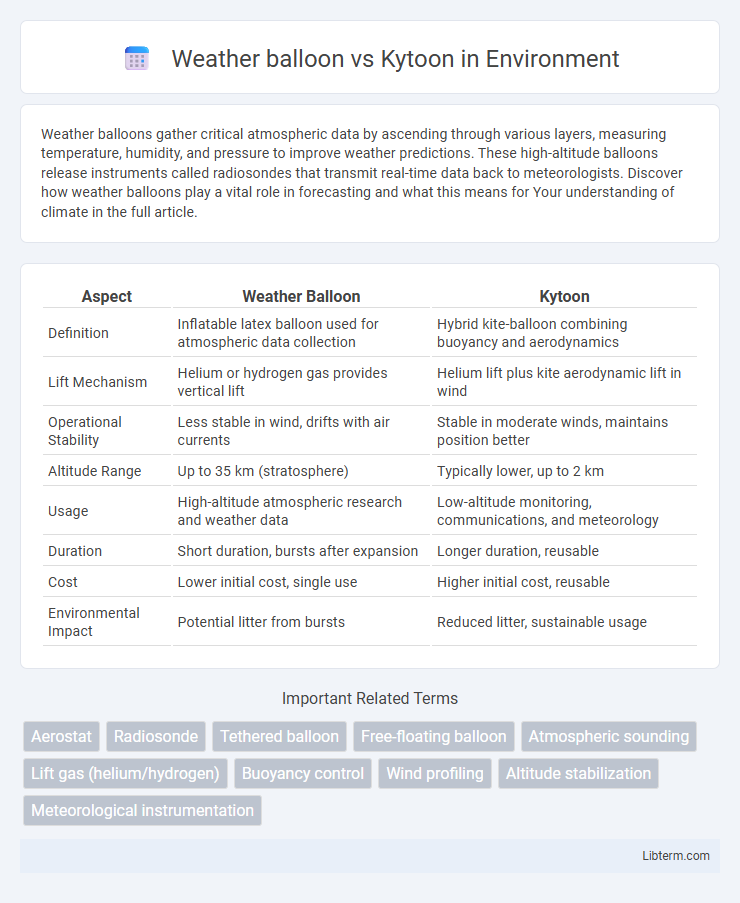Weather balloons gather critical atmospheric data by ascending through various layers, measuring temperature, humidity, and pressure to improve weather predictions. These high-altitude balloons release instruments called radiosondes that transmit real-time data back to meteorologists. Discover how weather balloons play a vital role in forecasting and what this means for Your understanding of climate in the full article.
Table of Comparison
| Aspect | Weather Balloon | Kytoon |
|---|---|---|
| Definition | Inflatable latex balloon used for atmospheric data collection | Hybrid kite-balloon combining buoyancy and aerodynamics |
| Lift Mechanism | Helium or hydrogen gas provides vertical lift | Helium lift plus kite aerodynamic lift in wind |
| Operational Stability | Less stable in wind, drifts with air currents | Stable in moderate winds, maintains position better |
| Altitude Range | Up to 35 km (stratosphere) | Typically lower, up to 2 km |
| Usage | High-altitude atmospheric research and weather data | Low-altitude monitoring, communications, and meteorology |
| Duration | Short duration, bursts after expansion | Longer duration, reusable |
| Cost | Lower initial cost, single use | Higher initial cost, reusable |
| Environmental Impact | Potential litter from bursts | Reduced litter, sustainable usage |
Introduction to Weather Balloons and Kytoons
Weather balloons are helium or hydrogen-filled rubber balloons designed to carry instruments for atmospheric data collection, reaching altitudes up to 40 kilometers. Kytoons combine the lifting power of both a balloon and a kite, remaining stable in winds while providing sustained elevation for communication or meteorological equipment. The unique design of kytoons enables them to maintain position in turbulent conditions, unlike traditional weather balloons that drift with upper-level winds.
Key Differences Between Weather Balloons and Kytoons
Weather balloons are spherical, helium-filled devices designed to rise through the atmosphere to collect meteorological data such as temperature, humidity, and pressure, reaching altitudes up to 120,000 feet. In contrast, kytoons are hybrid aerostats that combine balloon and kite characteristics, tethered for stability in windier conditions, and primarily used for stationary atmospheric monitoring or communication purposes. The key differences lie in operational altitude, lift mechanism (pure buoyancy vs. buoyancy with aerodynamic lift), and deployment applications, with weather balloons excelling in high-altitude data collection and kytoons offering sustained, stable positioning at lower altitudes.
Design and Structure Comparison
Weather balloons are typically spherical and made from latex or synthetic rubber, designed to expand as they ascend, allowing them to reach high altitudes before bursting. Kytoons combine features of kites and balloons, using a helium-filled envelope with aerodynamic surfaces to provide stability and lift in low wind conditions. The rigid frame of a kytoon contrasts with the flexible, expanding nature of weather balloons, making kytoons more stable in turbulent air but less capable of reaching extreme altitudes.
Lift Mechanisms: Helium, Hydrogen, and Wind
Weather balloons rely on the buoyant lift of helium or hydrogen gases, which are lighter-than-air substances that enable them to ascend vertically by displacing heavier atmospheric air. In contrast, kytoons combine gas lift with aerodynamic lift generated by wind acting on their kite-like structure, providing stability and maintaining altitude in varying wind conditions. The hybrid lift mechanism of kytoons allows for extended hovering capabilities compared to weather balloons, which are solely dependent on gas lift and susceptible to turbulence.
Typical Applications and Use Cases
Weather balloons are predominantly utilized in atmospheric data collection, meteorological research, and weather forecasting by reaching altitudes up to 40 km, making them ideal for vertical profiling of temperature, humidity, and pressure. Kytoons, combining balloon and kite characteristics, are commonly deployed for stationary aerial observation, communication relays, and environmental monitoring in regions with consistent winds, offering stable platform capabilities at lower altitudes than weather balloons. Both tools serve distinct roles in atmospheric science and telecommunications depending on the required altitude, stability, and deployment duration.
Altitude Capabilities and Flight Duration
Weather balloons reach altitudes between 20 to 40 kilometers, making them ideal for high-altitude atmospheric data collection, but their flight duration is limited to a few hours before bursting. Kytoons blend features of kites and balloons, maintaining sustained flight at lower altitudes up to approximately 1 kilometer with flight durations extending from days to weeks, supported by tethering and wind conditions. The choice between weather balloons and kytoons depends on mission requirements prioritizing either maximum altitude or prolonged airborne presence.
Advantages of Weather Balloons
Weather balloons offer superior altitude reach, capable of ascending up to 40 kilometers, which is significantly higher than most kytoons, enabling comprehensive atmospheric data collection. Their lightweight, cost-effectiveness, and ease of deployment make them ideal for short-term meteorological missions and scientific research. Unlike kytoons, weather balloons provide real-time telemetry and precise measurements of temperature, humidity, and pressure at various altitudes, essential for accurate weather forecasting and climate studies.
Advantages of Kytoons
Kytoons combine features of both kites and balloons, providing superior stability in varying wind conditions compared to traditional weather balloons. Their buoyancy and aerodynamic design allow for longer flight durations and precise positioning, making them ideal for extended atmospheric data collection. The ability to maintain altitude without constant ballast adjustments reduces operational costs and enhances measurement accuracy.
Limitations and Challenges
Weather balloons face limitations such as susceptibility to high-altitude winds causing drift and eventual burst due to pressure changes, restricting flight duration and data collection time. Kytoons encounter challenges including limited altitude reach compared to balloons and increased complexity in deployment because of their hybrid aerostat-helium design. Both platforms require careful consideration of weather conditions and payload weight to optimize performance and ensure data reliability.
Choosing Between a Weather Balloon and a Kytoon
When choosing between a weather balloon and a kytoon, consider altitude stability and payload capacity. Weather balloons excel at reaching high altitudes with minimal weight but offer limited stability due to drifting and burst risk. Kytoons provide a stable platform with better payload support and longer operational duration, particularly in windy conditions, making them ideal for fixed-location atmospheric studies.
Weather balloon Infographic

 libterm.com
libterm.com